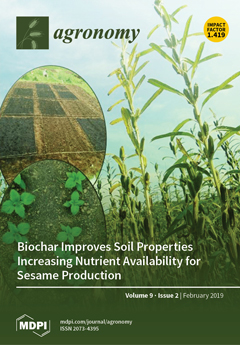Accurate estimation of the nitrogen (N) spatial distribution of rice (
Oryza sativa L.) is imperative when it is sought to maintain regional and global carbon balances. We systematically evaluated the normalized differences of the soil and plant analysis development (SPAD) index (the normalized difference SPAD indexes, NDSIs) between the upper (the first and second leaves from the top), and lower (the third and fourth leaves from the top) leaves of Japonica rice. Four multi-location, multi-N rate (0–390 kg ha
−1) field experiments were conducted using seven Japonica rice cultivars (9915, 27123, Wuxiangjing14, Wunyunjing19, Wunyunjing24, Liangyou9, and Yongyou8). Growth analyses were performed at different growth stages ranging from tillering (TI) to the ripening period (RP). We measured leaf N concentration (LNC), the N nutrition index (NNI), the NDSI, and rice grain yield at maturity. The relationships among the NDSI, LNC, and NNI at different growth stages showed that the NDSI values of the third and fourth fully expanded leaves more reliably reflected the N nutritional status than those of the first and second fully expanded leaves (LNC: NDSI
L3,4,
R2 > 0.81; NDSI
others, 0.77 >
R2 > 0.06; NNI: NDSI
L3,4,
R2 > 0.83; NDSI
others, 0.76 >
R2 > 0.07; all
p < 0.01). Two new diagnostic models based on the NDSI
L3,4 (from the tillering to the ripening period) can be used for effective diagnosis of the LNC and NNI, which exhibited reasonable distributions of residuals (LNC: relative root mean square error (RRMSE) = 0.0683; NNI: RRMSE = 0.0688;
p < 0.01). The relationship between grain yield, predicted yield, and NDSI
L3,4 were established during critical growth stages (from the stem elongation to the heading stages;
R2 = 0.53,
p < 0.01, RRMSE = 0.106). An NDSI
L3,4 high-yield change curve was drawn to describe critical NDSI
L3,4 values for a high-yield target (10.28 t ha
−1). Furthermore, dynamic-critical curve models based on the NDSI
L3,4 allowed a precise description of rice N status, facilitating the timing of fertilization decisions to optimize yields in the intensive rice cropping systems of eastern China.
Full article





